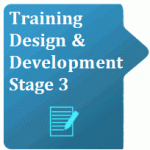
Once a training intervention is recommended, Needs Analysis must be conducted prior to the development of training. Different methodologies can be utilized to conduct a Needs Analysis.
Training Design and Development (TD&D) is the process that derives achievable objectives and training solutions from the outputs of the Needs Analysis. The first of the three stages of TD&D focuses on the formation of Training Objectives (TOs) to meet operational/business needs.
In the second stage of Training Design and Development (TD&D), training content is derived from Training Objectives (TOs), a strategy is created to assess training and the most appropriate training methods and media are selected. The result of this stage is the recommendation of a training solution.
The primary focus of the third and final stage of Training Design and Development (TD&D) is the development of Instructional Specifications (ISpecs) (i.e. lesson plans), Assessment Specifications (ASpecs), Course Specifications (CSpecs), and a Course Programme.
Once a clear definition of training requirements is established, the training must be delivered. Training Delivery must be conducted in accordance with the previously defined and approved training documentation, namely: ISpecs, ASpecs, CSpecs, and Course Programme.
Following the delivery of training, its impact is assessed in the Evaluation phase, to determine what has been achieved, evaluate the effectiveness of training and verify whether the training contributed to the achievement of organizational goals and targets. Validation, on the other hand, ensures that the training processes and products meet Defence requirements.
Training Needs Analysis (TNA) is typically triggered whenever new equipment is procured, or doctrine, organization or legislation undergo changes. In general, TNA should be conducted when a change in operational/business capability is likely to have a significant impact on training resources required (i.e., an increase or reduction).









